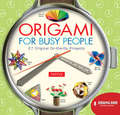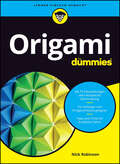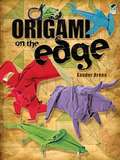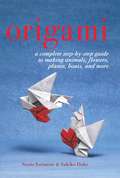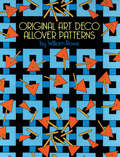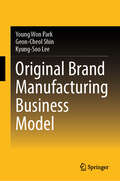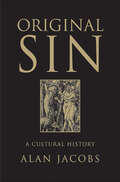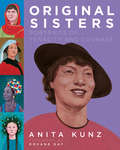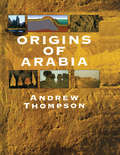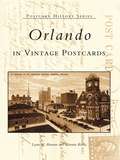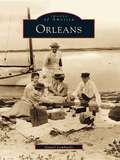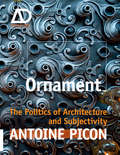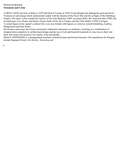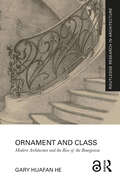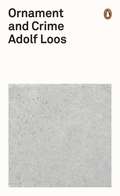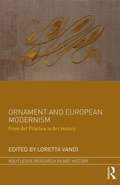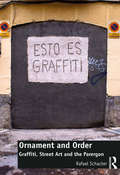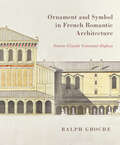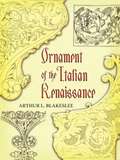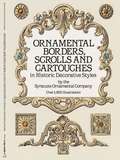- Table View
- List View
Origami for Busy People
by Marcia Joy MillerTurn a crazy, hectic work day around in just a few minutes with Origami for Busy People. Before jumping from one project to another, a little mental relaxation comes in handy to rejuvenate and revive the brain. This fun little book provides a variety of shorter and longer projects that can be completed during a coffee break, over lunch, or whenever a mini vacation is required.Projects include: Duck Glider Ghost Trigon Reversible StarSpring Flower Fluted Vase Starry SkyBasic folding techniques, color photos of the 27 projects and 48 tear-out folding sheets combine to make this handy book a new workplace favorite!
Origami from the Heart
by Florence TemkoMake beautiful origami valentines and love notes with this easy origami ebook.Use the art of origami to craft and create unique, personalized greeting cards from the heart! Perfect for those tired of sending dull, commercially produced cards, Origami from the Heart will help you wow that special someone with a handmade card just for them. This beautiful paper craft ebook will allow origami beginning to create not only fun and flirty origami love notes, but also envelopes just right for mailing their creations.All of the folds are simple enough to be origami-for-kids projects and are a great way to learn origami. This origami ebook contains:A full-colored 48-page book Step-by-step instruction and diagrams Paper folding basics and tips 16 fun origami valentines projectsIt's fun to create handmade origami cards, and doing so will give you a great feeling of satisfaction and accomplishment as well as another way of telling the recipient that you care.Origami Valentines include: Seal It with a Heart Valentine Unfold Me! Secret Note Photo Phrame Two Love Birds And many more...
Origami für Dummies (Für Dummies)
by Nick RobinsonMehr als nur Papiertiger Wollten Sie schon immer die uralte Kunst des Origami meistern? Dann ist dieses Buch genau das Richtige für Sie. Verständliche Schritt-für-Schritt-Anleitungen, bestehend aus Abbildungen und begleitendem Text, helfen Ihnen dabei, ein langweiliges Stück Papier in die verschiedensten Origami-Modelle zu verwandeln. Egal ob Anfänger oder Fortgeschrittener - für jeden ist das richtige dabei. Dabei gibt der Autor auch allgemeine Tipps zur perfekten Faltung, zum Erstellen eigener Modelle und verrät, was zu tun ist, wenn Sie mal nicht weiterwissen. So werden auch Sie zum Origami-Meister. Sie erfahren Wie Sie Grundformen falten und Papier einteilen Wie Sie neue Origami-Modelle entwerfen Wie Sie auch knifflige Modelle meistern Wie Sie mithilfe von Origami Spinnen lebend aus Ihrer Wohnung entfernen
Origami in the Classroom Book 2
by Chiyo ArakiIn an effort to educate American children further in origami, Japanese paper folding, author Chiyo Araki has written Origami in the Classroom Book 2, as a sequel to her first book. With handsomely drawn diagrams and accompanying step-by -step instructions, the author presents interesting paper-folding projects based on American annual holidays and events during winter through summer. Colorful examples, suggested grade levels, and necessary materials have been included as teaching aids.
Origami in the Classroom Book 2
by Chiyo ArakiIn an effort to educate American children further in origami, Japanese paper folding, author Chiyo Araki has written Origami in the Classroom Book 2, as a sequel to her first book. With handsomely drawn diagrams and accompanying step-by -step instructions, the author presents interesting paper-folding projects based on American annual holidays and events during winter through summer. Colorful examples, suggested grade levels, and necessary materials have been included as teaching aids.
Origami on the Edge
by Xander ArenaExperienced origami enthusiasts can explore new dimensions of this ancient art with sixteen unusual models that promise to please even the most particular paperfolders. Ranging in difficulty from intermediate to advanced, the projects include such creatures as a hammerhead shark, vampire bat, crocodile, rabbit, ghost bride, demon, chameleon, Brahma bull, polar bear, Komodo dragon, and Gila monster, plus a tank, sword, motorcycle, and more. Each one can be folded from a single square of paper--and clear, step-by-step diagrams make the instructions easy to follow. The results? Simply splendid! Includes full-color photos of all the completed projects on the covers.
Origami: A Complete Step-by-Step Guide to Making Animals, Flowers, Planes, Boats, and More
by Norio Torimoto Yukiko DukeA simple, elegant guide to making origami. From playful animals to delicate flowers and fun paper airplanes, this origami guide has projects that will delight both children and adults. With words, illustrations, and more than three hundred photographs, even the most complicated of folds and manipulations are made simple by this book’s easy-to-follow instructions. Master Norio Torimoto, with the help of Yukiko Duke, takes the mystery out of the art of paper folding by teaching readers the proper mindset behind the art and the basic formations that are the foundation for all his projects. Projects include: * Traditional tulip * Crane * Frog * Lily * Elephant * Tyrannosaurus rex * Envelope with a decorative heart * and more!
Original Art Deco Allover Patterns (Dover Pictorial Archive Ser.)
by William RoweThe stylized geometric forms of Art Deco continue to be extremely popular with today's artists, designers, and craftspeople. In this highly useful archive, William Rowe interprets this streamlined decorative style in his own unique way. The artist's wit and inventiveness pervade a wealth of artfully arranged circles, squares, triangles, and other geometric shapes.This book is really two books in one: a striking collection of royalty-free ready-to-use graphics, as well as a helpful guide, offering visual suggestions on how to adapt, develop, and vary designs. Mr. Rowe first presents a full-page design, then, on the opposite page, displays variants of the design. You'll find a total of 59 fascinating patterns in all -- ideal for use in textile, wallpaper, stationery, packaging, and a host of other graphic design projects.
Original Brand Manufacturing Business Model
by Young Won Park Geon-Cheol Shin Kyung-Soo LeeThis book aims to examine the transition of firms from original equipment manufacturing (OEM) and original design manufacturing (ODM) to original brand manufacturing (OBM), focusing on how businesses can evolve to capture greater value in global markets. It highlights the importance of digital technologies like IoT, big data, and AI in reshaping traditional business models, driving innovation, and enabling firms to move from cost-efficient manufacturing to building consumer-centric brands. The book provides insights into the challenges of this transformation, including structural barriers, market competition, and the need for significant investments in resources, innovation, and leadership. The book is divided into four sections. The first explores the historical evolution of OEM, ODM, and OBM business models and their transformation in the digital era. The second outlines key strategies for transitioning to OBM, covering global positioning, R&D, marketing, production, and supply chain management. It emphasizes the importance of design management, branding, and leveraging partnerships to achieve long-term competitiveness. The third section delves into sustainability and the circular economy, showcasing how OBM firms can integrate eco-friendly practices into their operations to enhance value and address growing consumer demand for sustainability. The final section provides an outlook on the future of OBM, with strategic pathways and policy recommendations to foster OBM business models. A deep case study in the cosmetics industry offers practical examples of successful transitions to OBM, illustrating diverse approaches and best practices. The book also introduces frameworks and tools for firms to assess and enhance their capabilities, providing actionable strategies for business leaders and policymakers. By addressing the complexities of moving up the value chain, this book serves as a roadmap for firms aiming to establish themselves as global leaders in innovation, branding, and sustainability.
Original Sin: A Cultural History
by Alan Jacobs“[A]n engaging and lucid work by a sophisticated Evangelical from the American South. . . . For all its American bias, Alan Jacobs’s highly readably ORIGINAL SIN might fill one of the gaps in the post-Christian memory banks.” — Times Literary Supplement (London)“One wouldn’t expect a book about original sin to be entertaining, but Jacobs makes it so with deft prose and a touch of humor.” — Christian Century“Jacobs is a superb writer whose work is beginning to get the wider notice it has long deserved.” — Books & Culture ("Top Ten Books of the Year")Alan Jacobs presents an engagingly written, eminently humane, and insightful account of an all-important subject that is both timeless and timely. — George Marsden, author of Jonathan Edwards: A Life“Alan Jacobs’ cultural history of the controversies that Saint Augustine’s concept gave birth to is fascinating, entertaining, wonderfully researched, and thoroughly even-tempered, giving even the most disagreeable voices their say. Original Sin may well become the definitive book on the subject.” — Ron Hansen , Author of Exiles and A Stay Against ConfusionI do not believe in original sin. I do believe in Alan Jacobs. He is one the smartest and wittiest writers around on matters involving religion, and ORIGINAL SIN is a gem. — Alan Wolfe, Boisi Center for Religion and American Public Life, Boston CollegeIn this brilliant account, Wheaton College literature professor Jacobs traces the idea of original sin from the Bible to the present day. . . . In his hands these abstruse theological disputes are utterly engrossing. — Publishers Weekly, starred review“With extraordinary erudition and just enough lightness of touch to leaven the lump, Alan Jacobs traces the tangled ways that we have tried to think about human cussedness. — Frederick Buechner, author of Secrets in the DarkReplete with examples drawn from a number of different cultural expressions, including literature, film, and philosophy, [Original Sin] is intended to introduce a broad genearl audience to the complexity of explaining how human beings act evilly toward one another. — Library JournalA brilliantly illuminating, deeply thought-provoking intellectual journey. — Booklist“A strangely entertaining cultural survey . . . ” — The Wall Street JournalJacobs’s discussion is terrifically worthwhile for exposing how the idea of “evil,” as enunciated iwthin the doctrine, undergoes permutations and translations over time — BN.comSplendid...a book endeavoring to help us say and do something about the sin which so easily ensares. Strikingly, Jacobs argues that the ‘confraternity’ of humanity is best grounded not in our being made in the image of God but in our being made sinful in Adam. Truly a revolutionary thought—that the roots of our common humanity might be found, not in our dignity or even our potential, but in our depravity.” — Books & Culture“A deep pool of wisdom . . . an expression of what’s wrong with all of us. Jacobs’ prose often sings . . . Careful when you open this book--it could keep you up at nights.” — Christianity Today“Follows the history of thinking about original sin from Augustine to ‘Hellboy’ and rewards the curious reader with unique knowledge (of good and evil) on every page.” — Beliefnet (Best Religious Book of the Year)“Jacobs’s flowing prose keeps the book moving at a nice pace.” — Weekly Standard
Original Sisters: Portraits of Tenacity and Courage (Pantheon Graphic Library)
by Anita KunzFrom the internationally acclaimed artist, a stunning collection of portraits of ground-breaking women—Joan of Arc, Josephine Baker, Greta Thunberg, Misty Copeland, and many more history-making women whose names have been forgotten and are finally being brought to light. With a Foreword by Roxane Gay &“This book, as a whole, offers the reader possibility and promise … You will be introduced to many of these women for the first time, because history is rarely kind to women until it is forced to be. You will learn about artists and activists, rulers and rebels.&” —Roxane Gay, from the Foreword Original Sisters was born from the COVID-19 quarantine. In early March 2020, locked down in her home-studio in Toronto and longing for inspiration, artist Anita Kunz started researching women on the Internet. She wasn&’t sure what she was looking for, but she soon found an array of astonishing people who had done amazing things—some of whom she had heard of, but most of whom she had not. And then she began to paint their pictures and write down their stories. The result is a jaw-dropping feat of historic and artistic research. The wide variety of lives, occupations, time periods, and achievements is absolutely mind-bending. From Joan of Arc to Josephine Baker, from Hippolyta to Greta Thunberg, from Anne Frank to Misty Copeland: these women made and changed history. But there are just as many whom you&’ve never heard of, who were never recognized in their lifetimes, whose achievements need to be brought to light. They include the anti-Nazi activist Sophie Scholl, who was executed at age twenty-one by the Third Reich, and Alice Ball, a young African American scientist who discovered a treatment for leprosy but died tragically before she could receive credit for it. This is not only a breathtaking art book. Original Sisters also recounts a secret history that must be told so that it is a secret no more.
Original Sisters: Portraits of Tenacity and Courage (Pantheon Graphic Library)
by Anita KunzFrom the internationally acclaimed artist, a stunning collection of portraits of ground-breaking women—Joan of Arc, Josephine Baker, Greta Thunberg, Misty Copeland, and many more history-making women whose names have been forgotten and are finally being brought to light. With a Foreword by Roxane Gay.&“This book, as a whole, offers the reader possibility and promise … You will be introduced to many of these women for the first time, because history is rarely kind to women until it is forced to be. You will learn about artists and activists, rulers and rebels.&” —Roxane Gay, from the Foreword Original Sisters was born from the COVID-19 quarantine. In early March 2020, locked down in her home-studio in Toronto and longing for inspiration, artist Anita Kunz started researching women on the Internet. She wasn&’t sure what she was looking for, but she soon found an array of astonishing people who had done amazing things—some of whom she had heard of, but most of whom she had not. And then she began to paint their pictures and write down their stories. The result is a jaw-dropping feat of historic and artistic research. The wide variety of lives, occupations, time periods, and achievements is absolutely mind-bending. From Joan of Arc to Josephine Baker, from Hippolyta to Greta Thunberg, from Anne Frank to Misty Copeland: these women made and changed history. But there are just as many whom you&’ve never heard of, who were never recognized in their lifetimes, whose achievements need to be brought to light. They include the anti-Nazi activist Sophie Scholl, who was executed at age twenty-one by the Third Reich, and Alice Ball, a young African American scientist who discovered a treatment for leprosy but died tragically before she could receive credit for it.This is not only a breathtaking art book. Original Sisters also recounts a secret history that must be told so that it is a secret no more.
Origins of Arabia
by Andrew ThompsonFirst Published in 2000. Routledge is an imprint of Taylor & Francis, an informa company.
Orlando (Queer Film Classics)
by Russell SheafferA film that transcends time, Sally Potter’s Orlando follows its titular character through nearly four hundred years of British history. Orlando starts life as a young man in the 1600s and then, mid-film, becomes a woman in the 1800s. Plot, production, and performance have all contributed to the film becoming a touchstone for Tilda Swinton’s ethereal and gender-bending mode.A Russian-French-Dutch-American-Italian-British co-production, Orlando was hailed as a monumental work of international art house cinema upon its release in 1992. Some understood Potter’s film, a work of ruthless and ingenious adaptation, as moving away from the lesbian content of Virginia Woolf’s novel. Russell Sheaffer uses a detailed analysis of screenplay drafts and more than three decades of reception to argue that while the film moves away from a direct investment in same-sex relationships, Orlando’s articulations of embodiment, desire, and time have made the film continually more queer in the years since its release.Taking cues from adaptation theory and gender studies, this book meticulously charts the distinct shift from lesbian feminist text to queer film classic, arguing that the film is as much an adaptation of Woolf’s A Room of One’s Own as it is of its eponymous novel.
Orlando in Vintage Postcards (Postcard History)
by Lynn M. Homan Thomas Reilly"Beautiful weather here. When are you coming?" Those words have been written millions of times on postcards mailed from Orlando. Known today as home to America's most famous theme parks, Orlando has always been a destination for visitors from all over the world. During its early period as "The Phenomenal City," through the years as "The City Beautiful," to the era of "The Action Center of Florida," Orlando has a story to tell.
Orleans
by Daniel LombardoOrleans, at the crook of Cape Cod's elbow, is a place of extraordinary beauty and unforgettable people. From the first known Cape Cod shipwreck, the Sparrowhawk in 1626, to the last Cape Cod wreck of a sailing ship, the Montclair in 1927, the town is bursting with tales to be told. There are the quiet stories of windmills, quahog fishermen, and cranberry harvesters set against the hanging of pirates, the threat of sea serpents, and attacks on Orleans by foreign countries. People flock to Rock Harbor on the west to watch the fishing boats go out or to watch the sun go down. Town Cove, with its windmill and inn, is on the north. To the east and south, Orleans opens up to the great Atlantic. The long spit of Nauset Beach is battered by the sea, as it protects Pleasant Bay and Pochet, Sampson, and Hog islands. With vivid photographs, Orleans brings to life the era of sailors such as Captain Linnell, who was as familiar with Calcutta and Hong Kong as he was with Rock Harbor; the time that Henry David Thoreau stayed at Higgins Tavern and met two young Italian organ grinders; and the day of the bombing of Orleans, when the Ainsleigh boy threatened a German submarine with his .22-caliber rifle.
Ornament
by Antoine PiconOnce condemned by Modernism and compared to a 'crime' by Adolf Loos, ornament has made a spectacular return in contemporary architecture. This is typified by the works of well-known architects such as Herzog & de Meuron, Sauerbruch Hutton, Farshid Moussavi Architecture and OMA. There is no doubt that these new ornamental tendencies are inseparable from innovations in computer technology. The proliferation of developments in design software has enabled architects to experiment afresh with texture, colour, pattern and topology.Though inextricably linked with digital tools and culture, Antoine Picon argues that some significant traits in ornament persist from earlier Western architectural traditions. These he defines as the 'subjective' - the human interaction that ornament requires in both its production and its reception - and the political. Contrary to the message conveyed by the founding fathers of modern architecture, traditional ornament was not meant only for pleasure. It conveyed vital information about the designation of buildings as well as about the rank of their owners. As such, it participated in the expression of social values, hierarchies and order. By bringing previous traditions in ornament under scrutiny, Picon makes us question the political issues at stake in today's ornamental revival. What does it tell us about present-day culture? Why are we presently so fearful of meaning in architecture? Could it be that by steering so vehemently away from symbolism, contemporary architecture is evading any explicit contribution to collective values?
Ornament And Crime
by Adolf LoosAdolf Loos, the great Viennese pioneer of modern architecture, was a hater of the fake, the fussy and the lavishly decorated, and a lover of stripped down, clean simplicity. He was also a writer of effervescent, caustic wit, as shown in this selection of essays on all aspects of design and aesthetics, from cities to glassware, furniture to footwear, architectural training to why 'the lack of ornament is a sign of intellectual power'.
Ornament and Class: Modern Architecture and the Rise of the Bourgeoisie (Routledge Research in Architecture)
by Gary Huafan HeThis groundbreaking study examines the intricate relationship between the rise of the nineteenth-century bourgeoisie and the emergence of modern architecture, exploring this connection through major intellectual and theoretical works while also analyzing their tangible manifestations in buildings and architectural projects.Contrary to received narratives that describe the birth of modern architecture as primarily an aesthetic movement, Ornament and Class argues that the social and political maturation of the European bourgeoisie as a distinct-yet-heterogeneous group influenced modern attitudes toward architecture at every level. Bringing architecture into conversation with recent histories of the bourgeoisie in the social sciences, the book considers how architecture was used as a tool to separate the modern bourgeoisie from the aristocratic and clerical forces above and the working classes below. It explores how architects, clients, planners, and administrators grappled with and dealt with ornament, architecture, and modernity from within the new realities of urban and global capitalism, and shows how these realities serve as pedagogical touchstones that remain with us today.Historians, architecture scholars, and students interested in modern architecture, aesthetics, and European history, especially those focusing on the interplay between modern architecture and social development, will find this book an invaluable resource.
Ornament and Crime
by Adolf LoosRevolutionary essays on design, aesthetics and materialism - from one of the great masters of modern architectureAdolf Loos, the great Viennese pioneer of modern architecture, was a hater of the fake, the fussy and the lavishly decorated, and a lover of stripped down, clean simplicity. He was also a writer of effervescent, caustic wit, as shown in this selection of essays on all aspects of design and aesthetics, from cities to glassware, furniture to footwear, architectural training to why 'the lack of ornament is a sign of intellectual power'.Translated by Shaun WhitesideWith an epilogue by Joseph Masheck
Ornament and European Modernism: From Art Practice to Art History (Routledge Research in Art History)
by Loretta VandiThese in-depth, historical, and critical essays study the meaning of ornament, the role it played in the formation of modernism, and its theoretical importance between the mid-nineteenth century and the late twentieth century in England and Germany. Ranging from Owen Jones to Ernst Gombrich through Gottfried Semper, Alois Riegl, August Schmarsow, Wilhelm Worringer, Adolf Loos, Henry van de Velde, and Hermann Muthesius, the contributors show how artistic theories are deeply related to the art practice of their own times, and how ornament is imbued with historical and social meaning.
Ornament and Order: Graffiti, Street Art and the Parergon
by Rafael SchacterOver the last forty years, graffiti and street-art have become a global phenomenon within the visual arts. Whilst they have increasingly been taken seriously by the art establishment (or perhaps the art market), their academic and popular examination still remains within old debates which argue over whether these acts are vandalism or art, and which examine the role of graffiti in gang culture and in terms of visual pollution. Based on an in-depth ethnographic study working with some of the world’s most influential Independent Public Artists, this book takes a completely new approach. Placing these illicit aesthetic practices within a broader historical, political, and aesthetic context, it argues that they are in fact both intrinsically ornamental (working within a classic architectonic framework), as well as innately ordered (within a highly ritualized, performative structure). Rather than disharmonic, destructive forms, rather than ones solely working within the dynamics of the market, these insurgent images are seen to reface rather than deface the city, operating within a modality of contemporary civic ritual. The book is divided into two main sections, Ornament and Order. Ornament focuses upon the physical artifacts themselves, the various meanings these public artists ascribe to their images as well as the tensions and communicative schemata emerging out of their material form. Using two very different understandings of political action, it places these illicit icons within the wider theoretical debate over the public sphere that they materially re-present. Order is focused more closely on the ephemeral trace of these spatial acts, the explicitly performative, practice-based elements of their aesthetic production. Exploring thematics such as carnival and play, risk and creativity, it tracks how the very residue of this cultural production structures and shapes the socio-ethico guidelines of these artists’ lifeworlds.
Ornament and Symbol in French Romantic Architecture: Simon-Claude Constant-Dufeux
by Ralph GhocheFor Simon-Claude Constant-Dufeux (1801–1871), a radical French architect and chair of perspective at the École des Beaux-Arts in Paris, the study and composition of ornament were essential pursuits. Architectural emblems and ornaments were symbols that conveyed concise and immediate meaning; they were also a crucial element in realizing the Romantic ideal of the synthesis of the arts.Through the lens of Constant-Dufeux’s work, Ornament and Symbol in French Romantic Architecture explores the sudden proliferation of ornamental motifs in France, challenging the understanding that the twentieth-century modernist avant-garde developed in direct opposition to ornament. Ralph Ghoche examines architectural ornament from the July Monarchy to the Second Empire, revealing its connections to Romantic theories of symbolism and ideas about the power of form to elicit emotional responses. Ghoche repositions Constant-Dufeux as a pivotal figure in developing new forms of symbolic signification in architecture, establishing him as one of Romanticism’s key theoreticians.Ornament and Symbol in French Romantic Architecture reconstructs vibrant debates surrounding theories of the symbol, the public function of architecture, and the quest for the synthesis of the arts, revealing architectural ornamentation to be part of a process of modernization that continued into the next generation of architects and artists, ultimately culminating in the advent of art nouveau.
Ornament of the Italian Renaissance
by Arthur L. BlakesleeThis glorious gallery of stunning architectural accents from Italy's Middle Ages has been assembled from a rare, early-twentieth-century publication: * Grotesques from carved panels of choir stalls* Breathtaking tombstone and ceiling ornaments * Sumptuous stone balcony panels... and much more, all reproduced in sixty richly detailed illustrations. Designers and artists of every variety will revel in this modestly priced treasury of authentic Renaissance style.
Ornamental Borders, Scrolls and Cartouches in Historic Decorative Styles (Dover Pictorial Archive)
by Syracuse Ornamental Co.Hundreds of beautiful copyright-free line illustrations of intricately carved furniture trimmings. Delicate floral wreaths, scrolls, more.
